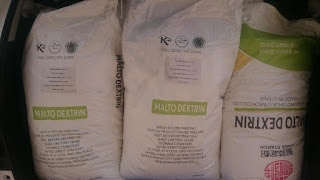What is
maltodextrin?
Maltodextrin is a white powder made from corn, rice, potato
starch, or wheat. Even though it comes from plants, it’s highly processed. To
make it, first the starches are cooked, and then acids or enzymes such as
heat-stable bacterial alpha-amylase are added to break it down further. The
resulting white powder is water-soluble and has a neutral taste.
Maltodextrins are closely related to corn syrup solids, with
the one difference being
their sugar content. Both undergo hydrolysis, a chemical process involving the
addition of water to further assist breakdown. However, after hydrolysis, corn
syrup solids are at least 20 percent sugar, while maltodextrin is less than 20
percent sugar.
Is
maltodextrin safe?
The U.S. Food and Drug Administration (FDA) has approved
maltodextrin as a safe food additive. It’s also included in the nutritional
value of food as part of the total carbohydrate count. According to the Dietary
Guidelines for Americans, carbohydrates should make up no more than 45–65 percent of
your overall calories. Ideally, most of those carbohydrates should be complex
carbohydrates that are rich in fiber, not foods that quickly raise your blood
sugar.
If you have diabetes or insulin resistance, or if your doctor has recommended a low-carbohydrate diet, you should include any maltodextrin you eat in
your total carbohydrate count for the day. However, maltodextrin is usually
only present in food in small amounts. It won’t have a significant effect on
your overall carbohydrate intake.
Maltodextrin is high on the glycemic index (GI), meaning that
it can cause a spike in your blood sugar. It’s safe to consume in very small
amounts, but those with diabetes should be particularly careful. Diets
consisting of largely low-GI foods are beneficial for everyone, not just people
with diabetes.
Why is
maltodextrin in your food?
Maltodextrin is generally used as a thickener or filler to
increase the volume of a processed food. It’s also a preservative that
increases the shelf life of packaged foods. It’s inexpensive and easy to
produce, so it’s useful for thickening products such as instant pudding and
gelatins, sauces, and salad dressings. It can also be combined with artificial
sweeteners to sweeten products such as canned fruits, desserts, and powdered
drinks. It’s even used as a thickener in personal care items such as lotion and
hair care products.
What’s the
nutritional value of maltodextrin?
Maltodextrin has 4 calories per gram — the same amount of
calories as sucrose, or table sugar. Like sugar, your body can digest
maltodextrin quickly, so it’s useful if you need a quick boost of calories and
energy. However, maltodextrin’s GI is higher than table sugar, ranging from 106
to 136. This means that it can raise your blood sugar level very quickly.
Maltodextrin is a polysaccharide that is
used as a food additive. It is produced from starch by
partial hydrolysis and is
usually found as a white hygroscopic spray-dried powder.
Maltodextrin is easily digestible, being absorbed as rapidly as glucose and
might be either moderately sweet or
almost flavorless. It is commonly used for the production of soft drinks and
candy. It can also be found as an ingredient in a
variety of other processed foods.
Maltodextrins are classified by DE (dextrose equivalent) and have a DE between 3 and 20. The higher the
DE value, the shorter the glucose chains, the higher the sweetness, the higher
the solubility, and the lower heat resistance. Above DE 20, the European Union's CN code calls
it glucose syrup; at DE
10 or lower the customs CN code nomenclature classifies maltodextrins as dextrins.
Maltodextrin is sometimes used
in beer brewing to increase the specific gravity of the final product.[5] This
improves themouthfeel of
the beer, increases head retention
and reduces the dryness of the drink. Maltodextrin is not fermented by yeast,
so it does not increase the alcohol content of the brew. It is also used in
some snacks such as potato chips and jerky. It is used in "light"
peanut butter to reduce the fat content, but keep the texture. Maltodextrin is
also sometimes taken as a supplement by bodybuilders and other athletes in
powder form or in gel packets.
Maltodextrin
is used as an inexpensive additive to thicken food products such as infant formula. It is also used as a filler in
sugar substitutes and other products.[6]
Source : https://en.wikipedia.org/wiki/Maltodextrin
Applications :
Pharmaceuticals
It’s used as an inert additive in the production of drug formulations
Biologically Active Supplements
It’s used as an inert additive in the production of biologically active additives. Maltodextrin promotes the growth of bifidus bacteria in the bowels that contributes to disbacteriosis prevention.
| |
| Food Industry
Maltodextrin is widely used in the production of bakery and confectionary, seasonings and sauces, instant food, beverage foods, dairy products, ice-cream, infant food, dietic food, etc. Maltodextrin is added into the products to improve the consistency and to preserve the properties of flavors and seasonings (as a taste intensifier). Maltodextrin improves and facilitates the process of proteins dissolution. It’s used as a thickener and builder in the puddings, soups and frozen food. It improves the gustatory quality and form of bakery and confectionary.
| |
| Cosmetology
It’s used in the production of body and face creams, balms and masks, as nourishing, emollient and purifying component; as a component of anti-age creams it promotes the reduction of mimic wrinkles and improves skin nutrition. It is used in hygienic powders, rouges, dry shampoos, compact powders, etc. Water solutions are used as a binding agent in the toothpastes formulas.
|
 |
| Maltodextri Indonesia |




